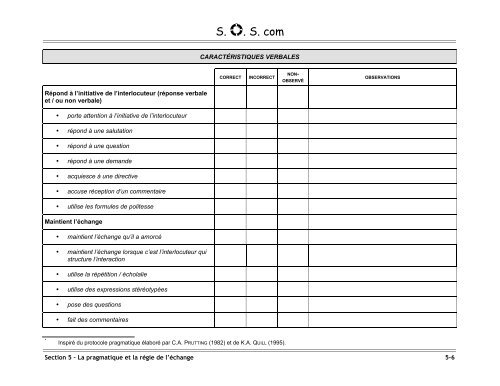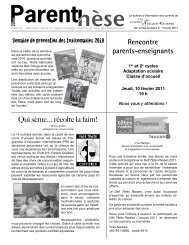Situations d'observation structurées de la communication
Situations d'observation structurées de la communication
Situations d'observation structurées de la communication
You also want an ePaper? Increase the reach of your titles
YUMPU automatically turns print PDFs into web optimized ePapers that Google loves.
Répond à l’initiative <strong>de</strong> l’interlocuteur (réponse verbale<br />
et / ou non verbale)<br />
*<br />
• porte attention à l’initiative <strong>de</strong> l’interlocuteur<br />
• répond à une salutation<br />
• répond à une question<br />
• répond à une <strong>de</strong>man<strong>de</strong><br />
• acquiesce à une directive<br />
• accuse réception d’un commentaire<br />
• utilise les formules <strong>de</strong> politesse<br />
Maintient l’échange<br />
• maintient l’échange qu’il a amorcé<br />
• maintient l’échange lorsque c’est l’interlocuteur qui<br />
structure l’interaction<br />
• utilise <strong>la</strong> répétition / écho<strong>la</strong>lie<br />
• utilise <strong>de</strong>s expressions stéréotypées<br />
• pose <strong>de</strong>s questions<br />
• fait <strong>de</strong>s commentaires<br />
S. . S. com<br />
CARACTÉRISTIQUES VERBALES<br />
CORRECT INCORRECT<br />
Inspiré du protocole pragmatique é<strong>la</strong>boré par C.A. PRUTTING (1982) et <strong>de</strong> K.A. QUILL (1995).<br />
Section 5 – La pragmatique et <strong>la</strong> régie <strong>de</strong> l’échange 5-6<br />
NON-<br />
OBSERVÉ<br />
OBSERVATIONS



